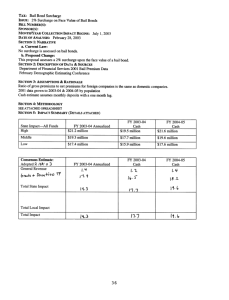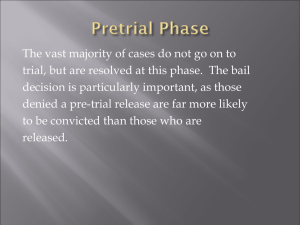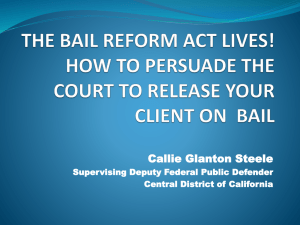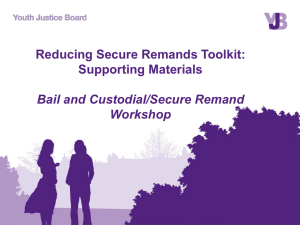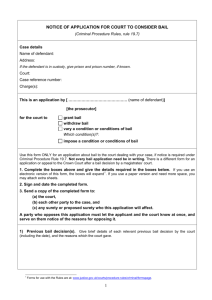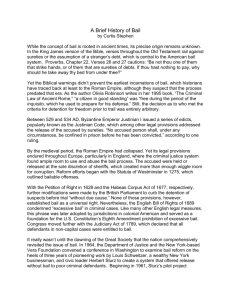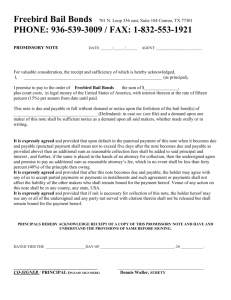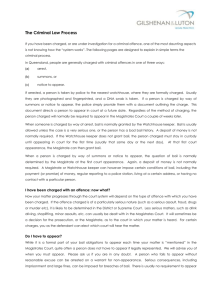Bail Observation Project - Inquiry into the use of Immigration Detention
advertisement
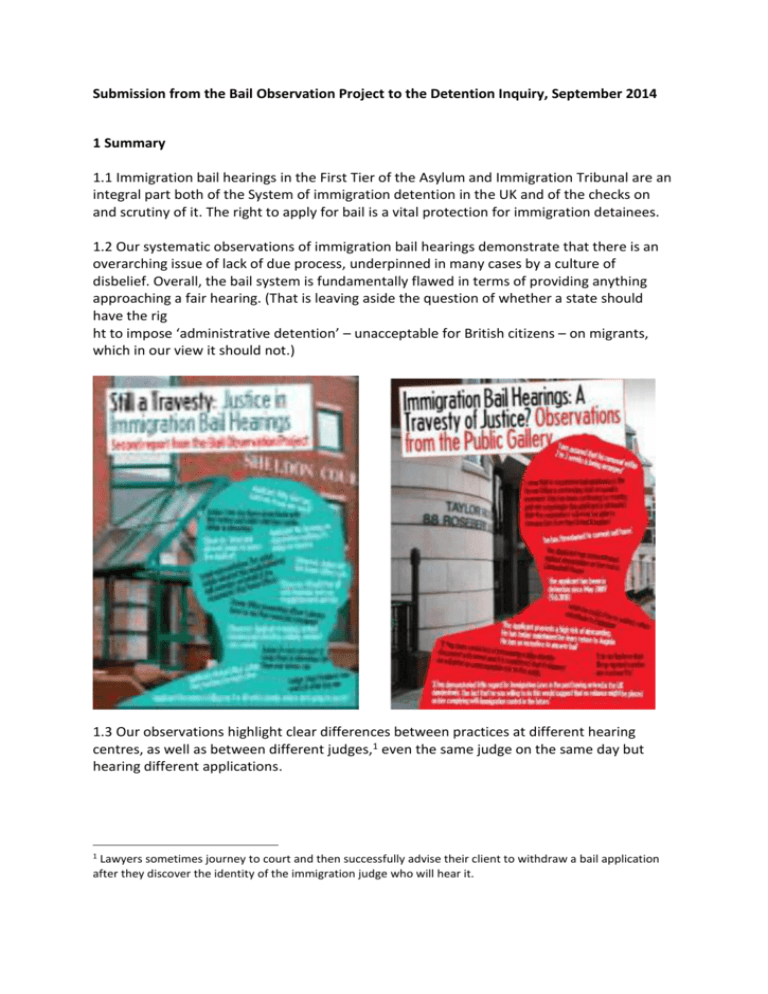
Submission from the Bail Observation Project to the Detention Inquiry, September 2014 1 Summary 1.1 Immigration bail hearings in the First Tier of the Asylum and Immigration Tribunal are an integral part both of the System of immigration detention in the UK and of the checks on and scrutiny of it. The right to apply for bail is a vital protection for immigration detainees. 1.2 Our systematic observations of immigration bail hearings demonstrate that there is an overarching issue of lack of due process, underpinned in many cases by a culture of disbelief. Overall, the bail system is fundamentally flawed in terms of providing anything approaching a fair hearing. (That is leaving aside the question of whether a state should have the rig ht to impose ‘administrative detention’ – unacceptable for British citizens – on migrants, which in our view it should not.) 1.3 Our observations highlight clear differences between practices at different hearing centres, as well as between different judges,1 even the same judge on the same day but hearing different applications. 1 Lawyers sometimes journey to court and then successfully advise their client to withdraw a bail application after they discover the identity of the immigration judge who will hear it. 1.4 They show the frustrations and repeated unfairness of the process as experienced by the lay people in the courts, be they observers, families, sureties or detainees. We make recommendations for change. 2 Why immigration bail matters 2.1 For the 30,000 men and women who are denied the basic right to liberty each year under immigration law in the UK, the right to apply for bail offers a precious if very limited chance of regaining the freedom to live in the community with family or friends. 2.2 It should be noted that, in the words of the official Bail Guidance for Judges (para 5), that bail is itself a restriction of liberty. 2.3 Moreover, there are many obstacles to obtaining bail: the lack of legal representation, lack of people regarded as appropriate by the courts to stand surety, long delays in obtaining an address acceptable to the UK Border Agency, the lack of effective interpreting and the process itself, whereby in nearly all cases the applicant appears by video link, putting him/her at a distance from all the other parties who are obliged to be present in the court. In many cases this leads to the applicant being ignored. (see section 7 on videolink.) Drawing of Applicant in video link room and what he/she sees on the screen 2.4 Many bail applicants should not, under the UK Border Agency’s own Enforcement Instructions and Guidance3 (Chapter 55.3.1) have been detained, including: unaccompanied children the elderly pregnant women those suffering from serious medical conditions the mentally ill torture survivors people with serious disabilities victims of trafficking The government is often in breach of its own policy on the matter. Our observations show that immigration judges2 often ignore this and fail to demonstrate their independence from the detaining power. 2.5 Bail hearings are seldom attended by members of the public, still less by media reporters. To the knowledge of the Bail Observation Project, in 335 bail hearings observed over three years, only one other member of the public was present in court, apart from those with a direct interest in the outcome such as the family and friends of the applicant. 2.6 In the long run, for justice to be done, it has to be seen, seen in the sense of scrutinised by the public. 2.7 Our observations show that the presence of observers in court affects the outcome of hearings 2.8 A further reason for observing bail hearings is that the presence of observers appears to provide a distinct advantage to the bail applicant. In observations made in 2009-10 of applications that went ahead (were not withdrawn) where a member of the public was present in court, applicants were successful in 33 out of 93 hearings (35%), compared with national figures for 2009 of 2220 of 8055 (25%). In our 2012 observations the comparable figures were 76 of 171 (44%), and nationally 2450 of 5065 (33%). FINDINGS OF OUR OBSERVATIONS 3 Conduct of immigration judges 4.1 Judges were observed to: 2 not treat the bail applicant with respect; show bias towards or not question, in the absence of a legal representative for the applicant, the Home Office’s position, in particular unsubstantiated claims in the Bail Summary. In the majority of cases observed in 2012 (142 of 168 for which the information was recorded), the judge allowed the Home Office’s Bail Summary to go unchallenged and did not require the Home Office to provide evidence for the statements made in it; not guide the applicant where he/she lacked a legal representative (42 of 77 hearings in which an observation of this was made); not ensure at regular intervals that the applicant understood proceedings (112 of 169 hearings in which an observation of this was made); be inflexible towards the position or request of the applicant; not admit sureties to the court (27% of observed cases); appear to have made up their minds before hearing the evidence; Common parlance. The correct term is (currently) First-tier Tribunal Judge. not to follow the Bail Guidance to judges3, by for example: failing to give consideration to the length of time an applicant had been detained; failing to require the Home Office to demonstrate that removal is indeed imminent as alleged; failing to ascertain that alternatives to detention have been pursued; failing to challenge unsubstantiated claims about the likelihood of the applicant absconding (not reporting). 3.2 One case shocked the observer. The judge did not ask if there was a bail summary, the HOPO said nothing throughout the hearing, the applicant had no legal representation but said he did not want to go home, had lived in the UK for 10 years, did not have a criminal record and wanted to claim the right to stay under the Human Rights Act. This was not pursued. Refusing bail the judge said: This bail application is dismissed for reasons I am writing down and which you will receive. The hearing was over in under ten minutes. The judge, the detainee and the Home Office representative – extract from a complaint by A.A., detained at Campsfield detention centre, about his bail hearing held via video link4 “My video link bail hearing of 28 July 2011 was presided over by a judge who, from the outset, demonstrates an apparent inadequate knowledge and the correct understanding of my case. The manner in which he handled my case clearly suggests that he did not read a bit of my case before the hearing. His one clear mission is to intimidate me and then refuse my bail. As a judge he is picturesquely autocratic. “This judge completely ignored the ethical requirement of the profession that gives no room for any partiality between the contending parties. He addresses me uncaring of the consequences of his utterances. The hatred he has for me was so manifest. He was blunt in his approach and he was openly prejudiced against me. I felt so humiliated by his actions! ... “The Home Office representative appeared to confirm my side of the story when she indicates that I have a judicial review pending. The judge then asked me to explain what my judicial review was about and the Home Office 3 Tribunals Judiciary, Immigration and Asylum Chamber, Mr Clements (2012), Bail Guidance for Judges Presiding over Immigration and Asylum Hearings, Presidential Guidance note no. 1 of 2012 (implemented on Monday 11th June 2012) 4 Full text of complaint: http://closecampsfield.wordpress.com/2011/09/04/immigration-bail-hearings-atravesty-of-justice-a-detainees-view/ representative responded saying it was for unlawful detention. ... The judge argued emphatically that my judicial review will be refused at the oral hearing. I asked him how he knew it would be refused, and he asserted: because I know it will be definitely refused. That is the only answer you will get! He concluded saying that he will not grant me bail because of my judicial review. ... “He reacted stating that his advice for me was to withdraw all my judicial review claims and get on the plane to Nigeria if I do not want to continue suffering myself in detention. He said I’m the one suffering myself and he could not help my situation unless I help myself by getting on the plane to Nigeria. He never commented on my medications and condition in particular but concluded that the onus is on me to save myself the pain of detention…. “I left the video link room highly traumatised.” Our recommendations: i) Judges must be consistent in not showing bias in favour of the representative of the state, the Home Office presenting officer (HOPO.) ii) The immigration judge should demonstrate that he/she is approaching each bail hearing with a presumption of liberty, where the burden of proof lies with the Home Office to provide evidence of the absolute necessity for detention. iii) The immigration judge should show proper human respect to all parties, particularly the applicant, who is in a vulnerable position. iv) The applicant must be given sufficient time to speak and to be listened to, and accorded proper dignity. v) Home Office statements about the likelihood of absconding should not be part of the bail summary unless there is evidence to back them up. vi) Provision should be made where the applicant does not have command of the English language, particularly where the applicant is not represented, for the bail summary to be translated into the language of the applicant, before the bail hearing. vii) More attention should be paid by immigration judges to the issue of length of time the applicant has been in detention, and the detrimental effects of continued detention on the applicant and any family or dependents. viii) There should be a practice direction, putting the burden of proof on the Home Office to demonstrate, with evidence, imminence of removal, and to show that alternatives to detention are not adequate (i.e. to show detention is ‘necessary’). ix) Failure by the Home Office to carry out what was directed by an immigration judge at a previous hearing should normally be sufficient reason for granting bail. 4 The right to legal representation 4.1 Good legal representation is key to a successful bail hearing. In observations made in 2012, 68 applicants had no lawyer to present their case and of these only 7 (10.3 %) were granted bail. 47 (69%) were refused, and 14 withdrew their application. This compares with a success rate for those with legal representation of 48% (69 of 145). Our recommendations: x) There should be an automatic right to free legal representation in bail applications. xi) An unrepresented applicant, whether appearing in person or by video link, should have the right to be accompanied by a Mackenzie Friend, sitting at his/her side. xii) Applicants appearing by video link are entitled to as much time with their lawyer as applicants appearing in person. Ten minutes is not sufficient time for lawyers to consult with their clients before the start of a hearing by video link. This is even more the case if interpreting is required or prior to a joint hearing. 5 Treatment of sureties and public 5.1 Sureties may travel far and lose a day’s pay to come to court. They are sometimes not admitted to court, subjected to bullying or intrusive questioning and are otherwise treated disrespectfully. Our recommendations: xiii) Sureties who came to the bail hearings were often not admitted. Sureties should be admitted from the beginning of all bail hearings. xiv) The observed tendancy to an increase in aggressive and intrusive line of questioning of sureties by some HOPOs and some immigration judges should be reversed. xv) The public should be admitted to all bail hearings without questioning. 6 Use of video link in courts 6.1 Hearings by video link have now become standard. Out of 212 hearings observed in 2012-13, 168 were by video link. The argument for the process is that video link hearings are cost effective. However, not only is it stressful for detainees but the figures suggest that it may be an obstacle to a fair hearing. Bail was granted to 21 out of 41 applicants appearing in person (51%), but of 170 appearing by videolink, only 54 applicants (32%) were granted bail. The breadth of objections to video link has been recorded elsewhere.5 The applicant in a videolink hearing watches the distant figures in court Our recommendations: xvi) Video link hearings should be discontinued as our observations show that they are not able to deliver a fair hearing. xvii) Until such time, detainees should be able to choose, as a matter of course and not as an exception, between a hearing in person and one by video link. xviii) Technical improvements are needed including a facility for the applicant to see the other main participants in the hearing in close up (see facial expressions) not as ‘stick figures’ in the distance, and for lighting to be sufficient for the applicant’s facial expression to be seen clearly in court. 7 Interpretation and the use of private companies 7.1 The quality of interpreter services since they were privatised has been severely criticised, notably by the House of Commons Justice Select Committee.6 Our recommendations highlight the shortcomings observed, which can result in an unjustified continuation of the deprivation of liberty of a person. 5 Gill, N., Conlon, D., Oeppen, C. and Tyler, I. (2012) 'Networks of Asylum Support in the UK and USA: a Handbook of Ideas, Strategies and Best Practice for Asylum Support Groups in a Challenging Social and Economic Climate', 15 March 2012, pages 19-20, section on video-link: http://steedee.files.wordpress.com/2012/03/networks-of-asylum-support-print2.pdf 6 http://www.parliament.uk/business/committees/committees-a-z/commons-select/justicecommittee/news/interpreters-andals-report/ 7.2 Private companies have been instrumental in promoting, and greatly benefited from, the great increase in immigration in the UK.7 G4s, Serco, and Mitie run most of the detention centres in the UK. The same business interest can be at seen at work in the provision of a much wider range of services in the UK related to immigration detention including tagging, deportations, white van transports, and videolink. 7.3 As well as additional financial costs and corner-cutting, there is also a moral aspect to privatisation of a decrease in accountability. The policy of using private contractors allows the government to duck its responsibilities. 7.4 Fiascos in this area including Serco and Group4 tagging scandal, Capita’s threatening Christmas texts to thousands of migrants that they did not have the right to be in the UK, when many of them reportedly had valid visas, and the killing of Jimmy Mubenga by G4S ‘escorts’ on a British Airways aircraft at Heathrow. Our recommendations: xix) Appropriate interpreters should always be available. xx) Interpreters should interpret the entire proceedings. xxi) Sufficient time must be made available for the interpreter to carry out this task. xxii) The interpreting service should be subject to more stringent quality control. xxiii) Interpreting services should be brought back in-house. xxiv) A transparent audit of all services provided by profit-orientated private companies should be carried out with a view to regulating, reducing and/or ending such provision. 8 Record of proceedings 8.1 The conduct of hearings, and of judges, cannot be monitored effectively, and the judges’ decisions cannot always be effectively challenged, without a record, accessible to all interested parties, of the entire proceedings of the hearing. Despite assurances by the president of the First tier of the AIT, Mr Clements, in two annual reports that audio recordings would be introduced, a move towards this has been reversed. Our recommendation: xxv) There should be written or audio record of the entire proceedings at bail and other hearings in immigration courts, available to interested parties. 7 Christine Bacon (2005), The evolution of immigration detention in the UK: The involvement of private prison companies, Oxford: Refugee Studies Centre working paper 27. Judges – by C.C., a detainee8 Have you ever been to a court and watch any of the judges? Those people carry some serious grudges Don’t get me wrong, breaking the law must be punish But if you’re innocent, your life shouldn’t be tarnish People who are guilty are getting away free The ones that are innocent, lost their liberty Most judges don’t use their moral authority Some just trample on one’s dignity I would like to see justice serve right Not by someone using their might I have seen judges made up their mind before the case is tried By punishing victims because someone lied Have you ever been to court for a trial? You have to be firm while fighting for survival Those egoistic people go on like they are God But in their home they are treated like a Cod There can be no peace without any justice Time after time the UK Border Agency abused its office I have even seen judges abusing their power In the eyes of the law, they are treated differently from the others What kind of example those judges are setting? The justice system is only being, belittling. 9 Training and monitoring of immigration judges 9.1 Shortcomings in the observed conduct indicate that scrutiny, monitoring, inspection and training of immigration judges need to be either introduced or improved. 8 http://closecampsfield.files.wordpress.com/2011/03/ccc-bop-report-low-res.pdf page 1. Our recommendation: xxvi) All immigration judges should receive training in using the Bail Guidance. Moreover current training The training of immigration judges should be reviewed to ensure that more weight is given than is currently often the case to: Independent (including medical) evidence The effects of detention on the mental health of detainees and the well being of their families and dependents and the consequent undesirability of prolonging detention Ongoing familiarisation with current conditions in the country of origin of bail applicants Monitoring of performance should be routine to ensure standards are maintained. Observation of bail hearings before hearing bail applications Facilitating a fair hearing for unrepresented applicants Ensuring the appropriate use of interpreting services. Awareness, through visits, of healthcare provision and general conditions in detention centres. 10 The Bail Observation Project 10.1 The Bail Observation Project was established in 2009. Over the next four years, some 35 trained lay observers attended 335 bail hearings at four different hearing centres in London, Birmingham and Newport. In drawing up the questionnaire used and obtaining training for the observers, BOP was assisted by former detainees, and members of the Immigration Law Practitioners Association and Bail for immigration Detainees. Two reports were published and launched with meetings in Oxford and the Houses of Parliament: Bail Observation Project (2011) Immigration Bail Hearings: A Travesty of Justice? Observations from the Public Gallery,9 BOP (2013) Still a Travesty: Justice in Immigration Bail Hearings.10 9 http://closecampsfield.files.wordpress.com/2011/03/ccc-bop-report-low-res.pdf 10 http://closecampsfield.files.wordpress.com/2013/04/2nd-bop-report-final.pdf. Other surveys of immigration bail hearings are Bail for Immigration Detainees (BID) (2010), A Nice Judge on a Good Day: Immigration Bail and the Right to Liberty, London, and BID (2012), The Liberty Deficit: Long-term Detention and Bail Decision Making, A Study of Immigration Bail Hearings in the First Tier Tribunal, London. An article by a member of the Bail Observation Project is Caroline White (2012), ‘”Get me out of here”: Bail hearings of people indefinitely detained for immigration purposes’, Anthropology Today, vol. 28, no.3,, pp. 3-6(4), June: http://onlinelibrary.wiley.com/doi/10.1111/j.1467-8322.2012.00870.x/abstract 10.2 Since 2013 BOP has been represented at meetings of the Stakeholder meetings of the Asylum and Immigration Tribunal, where it has continued to press for its recommendations to be adopted. 10.3 The Project’s current activity is focused on enabling others to spread the public’s scrutiny of the workings of the bail courts. This is being done by focusing on university law departments with the aim of getting law students to carry out their own observations and produce reports. BOP is currently working with 8 law schools to that end. 10.4 The Project is a member of the Judicial Oversight Working group of the Detention Forum. Ends 30 September 2014
